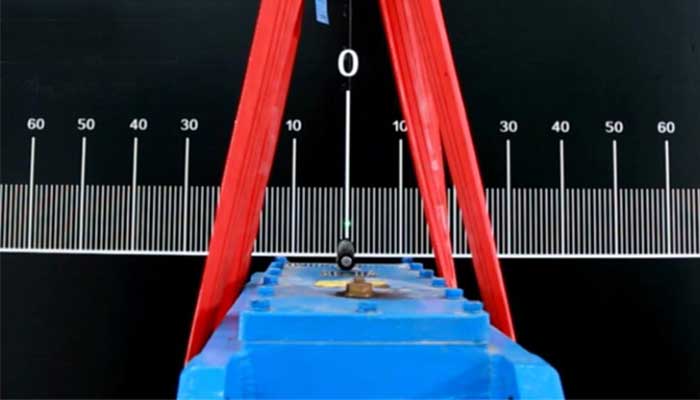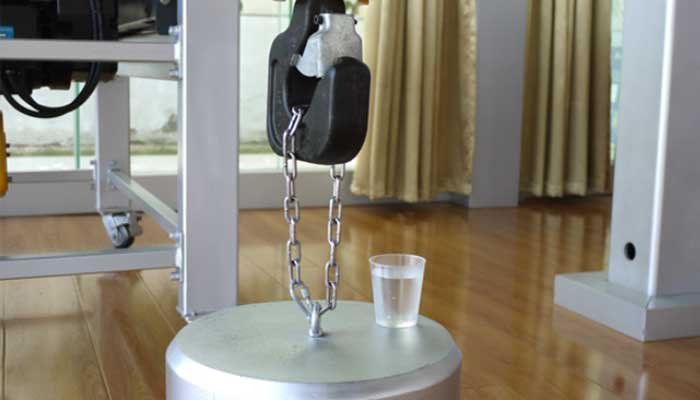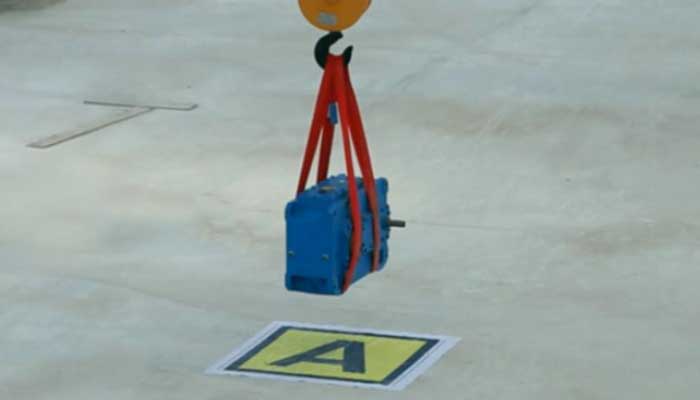Anti-sway:Stop Overhead Crane & Gantry Crane Loads Sway
Anti-sway crane systems stop overhead crane load sway, reduce operation time, improve handling efficicy & safety. More on overhead crane swing control.
Overhead cranes are essential lifting equipment for large cargo movement at seaports, steel mills, and other enterprises. As a typical underactuated system, an overhead crane is easily affected by various external disturbances, causing the load to swing frequently during transportation, seriously affecting the positioning accuracy of the load and bringing many unsafe possibilities while reducing system efficiency.
The key considerations are avoiding the upload swing and increasing safety and efficiency. As a result, the control objective of an overhead crane normally involves two parts: fast and accurate placement and effective swing suppression, particularly when external resistance (such as wind resistance and stochastic collision) is included during upload transfer.This article will present you how to stop overhead cranes from swinging and keep you and your staff safe when utilizing these devices.

Risks of Swinging Overhead Cranes
Overhead cranes are an important equipment in many sectors because they allow for the efficient movement of huge cargo. However, if necessary precautions are not taken, their use can be hazardous. Swinging is one of the most serious hazards associated with EOT cranes.
Swinging happens when a weight being carried by a crane swings back and forth, which can be caused by operator mistake or external forces such as wind. This swinging action is unexpected and difficult to regulate, which frequently leads to accidents and injuries.
One of the most serious risks of bridge crane swinging is that the weight may collide with other objects, potentially inflicting damage and harm. For example, if a load swings into a neighboring piece of equipment or building, both the load and the object it collides with may be damaged. Furthermore, if the load strikes a person, it could cause major harm or even death.
Another risk of crane swinging is that it can cause the lifting crane to become unstable. When a load swings, additional forces are applied to the crane's framework, which might cause it to tip over or collapse. This can lead to catastrophic mishaps and injuries to nearby personnel and property.
Importance of Avoiding Overhead Crane Swing
When a crane swings, it can endanger the lives of crane operators, other construction workers, and adjacent bystanders. Here are a few specific reasons why preventing crane swinging is critical:
1. Protect life
One of the most essential reasons to keep bridge cranes from swinging is to keep people safe. A bridge crane that loses control can cause significant injury or even death. The burden could strike workers on the ground, causing significant injury or death. Similarly, crane operators may lose control, resulting in a devastating accident. We can considerably reduce the danger of accidents and protect the safety of all personnel on the job site by stopping the electric overhead crane from swinging.
2. On the job site, safeguard materials and equipment.
Another important reason for keeping overhead cranes from swinging is to protect supplies and equipment on the job site. The crane's uncontrolled swinging could force the weight to collide with other equipment or materials, causing damage or destruction. This can lead to considerable financial losses for the organization and project delays. We may avoid such costly disasters by avoiding swinging and ensuring that all equipment and materials remain safe and unharmed.
3. Maintain Job Site Productivity and Efficiency
Preventing bridge cranes from swinging also helps to maintain job site productivity and efficiency. When a crane swings out of control, workers must cease working until the crane can be brought back under control. As a result, time is lost and efficiency suffers. We can avoid swinging by ensuring that work remains uninterrupted and deadlines are met on time.
4. Legal and regulatory compliance
Finally, preventing overhead cranes from swinging is critical for legal and regulatory compliance. Overhead cranes must be used safely, according to strict safety rules. If a corporation does to follow these standards and an accident happens, it may face serious legal and financial implications. Companies can avoid such penalties and remain in compliance with safety standards by ensuring that overhead cranes are utilized safely.
Benefits of swing control on overhead cranes
The benefits of electrical anti-swing cranes are presented for your reference.
- Reduce swing wait time so that the OH crane's work efficiency increases by 30% or more.
- Increase crane safety and limit the risk of injury to people and operational locations.
- Convert cranes into a "crane robot" for autonomous material handling control.
- Increase the crane's safe operation speed while also increasing its efficiency.
- Make the crane simple to operate, decrease staff training time, and lower the labor intensity of employee operation.
- Increase the lifting crane's safe working space.
- Increase the crane's mechanical life.
- Can be used by overhead and gantry cranes.
- Set up dangerous places in advance so that the control system can avoid them automatically.
- Vertical system to eliminate deviation and adjust the operating position automatically.
- Hook pushing function, which allows the crane to run automatically while pushing the hook.

What are the cause of loading swing ?
Before we explore how to avoid swinging, we must first understand what causes this problem. The following are some of the most prevalent reasons why bridge cranes swing:
1. Uneven or unbalanced overhead crane loads
One of the most common reasons of overhead crane swaying is uneven or unbalanced loads. When a weight is not uniformly distributed, an imbalance occurs, causing the load to swing back and forth as the crane moves. This swinging action is hazardous and may cause damage to the bridge crane, the weight, or both. Uneven weight distribution, incorrect rigging, and insufficient information about the load being lifted are all factors that contribute to uneven or unbalanced loads.
2. Wind or other external factors
One of the most typical environmental elements that can cause an overhead and gantry crane to swing is wind. Even a gentle breeze might cause a hung weight to sway back and forth. This is especially problematic in places with heavy winds, as the wind can cause significant movement in both the cargo and the crane itself. Wind gusts can knock the crane and its weight off track, forcing it to swing wildly.
3. Unskilled Overhead Crane Operator
Another possible cause of bridge crane swaying is an inexperienced operator. Overhead crane operation necessitates a particular amount of expertise, knowledge, and experience. If an operator is inexperienced or unskilled, they may be unable to successfully control the crane's movements, resulting in swinging. For example, an inexperienced operator may be unaware of the best techniques for regulating movement and preventing swinging when operating an overhead crane. This can result in dangerous lifting and load motions that result in swinging.
4. Mechanical Failure
Another potential cause of overhead crane swaying is mechanical failure. The electric travelling cranes are sophisticated equipment with many moving parts, and any failure of these components can cause instability and swinging. Here are several potential mechanical faults that might cause bridge crane swinging: Worn or damaged brakes, faulty hoist controls, broken sheaves or pulleys.
How to prevent overhead crane swinging
Several precautions are taken to prevent load handling crane swinging, including:
1. Proper Load Balancing
Proper load balancing is one of the suggestions for keeping overhead cranes from swinging. When hoisting a cargo, it is critical to ensure that the weight is adequately distributed across the crane's hoist ropes. An imbalanced load might cause the bridge crane to swing as the weight shifts from side to side. To avoid this, identify the load's center of gravity and arrange it properly. This can be accomplished through mathematical calculations or the use of equipment such as load cells.
2. Measurement of Wind Speed
One of the key causes of crane swinging is wind speed. As a result, it is critical to monitor wind speed before beginning any lift operation. If the wind speed exceeds the recommended limit, the crane operator should halt the operation until the gusts subside.
3. Proper Overhead Crane Operator Training
Crane operators must have adequate training in order to operate the crane safely and successfully. Understanding load limitations, suitable rigging procedures, and how to avoid swinging are all part of this. Operators should also be instructed on how to recognize potential threats and respond in an emergency. Accidents caused by crane swinging can be considerably reduced with proper training.
4. Regular Inspection And Maintenance
Overhead cranes should be inspected on a regular basis to ensure they are in good working order. Checking the hoist ropes for evidence of wear or damage, evaluating the crane's structure for signs of corrosion or cracks, and testing the brakes and other safety measures are all part of this process. Equipment failure, which is a typical cause of crane swinging, can be avoided with regular maintenance.
5. Make use of anti-sway devices
A crane anti-rocking device is a safety feature that prevents cranes from excessively swaying or rocking during operation. This technology works by employing sensors to detect any crane movements and then automatically adjusting the crane's motions to counteract them, assuring the crane's stability and safety.
These devices can be mechanical or electrical in nature. Electrical anti-sway systems and inverted figure-of-eight wire rope anti-sway systems are commonly utilized. The electrical anti-sway system may eliminate sway by more than 90%, enhance productivity by more than 30%, and accurately position the crane in less time, decreasing the operator's labor intensity, enhancing safety, and extending the crane's life. The inverted octagonal anti-sway system is simple, inexpensive, and effective to use.
Swinging overhead cranes can pose serious safety hazards in industrial environments. Understanding the causes of swinging and applying the tips stated above will help you avoid this problem and safeguard the safety of your employees.




